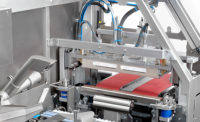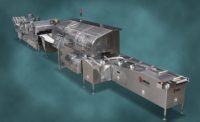Consumers are demanding a much wider range of snack products and baked goods. By adapting the packaging design and look of their product, producers can easily update their portfolio to help maintain visibility and market relevance. And to help them stay in step, bagging machines continue to grow more versatile and efficient.
Weighing options
“Over the last 12 months, we have seen greater demand for faster, more versatile systems as bakery/snack producers face increasing demand from retailers to provide products in different bag styles and sizes,” says Paul Wilkinson, business development manager, Pacemaker Services, Essex, England. “Today, automation needs to handle a wide range of bags, with the ability to run higher payloads at increased speeds. Also, by offering universal bagging equipment, we reduce the equipment footprint and lower initial investment.”
The latest bagging machines are designed to support easy changeovers, says Mark Lozano, sales manager, North America, tna, Dallas. “No mechanical adjustments are needed when changing product or film on new machines; plus, digital data settings are incorporated into the systems for rapid product or pack changes.”
Many bagging machines now allow for quick format changes and any combination of jaw size or configuration (rotary single, double, triple or rotary flat jaw), granting full flexibility of bag size and format, film type and application on a single system, Lozano adds.
WeighPack Systems Inc., Montreal, manufactures a wide range of automatic packaging solutions that encompass a variety of bag styles. “We prefer to provide individual machines that master specific bag styles, as opposed to producing a machine that is a jack of all trades,” says Nicholas Taraborelli, vice president of sales and marketing.
“A good example of this concept is vertical form/fill/seal (FFS) machines that produce pillow pouches, gusseted bags and Doy-style stand-up pouches. A vertical FFS machine cannot match the quality of aesthetics that a horizontal FFS machine like our R2B (roll-to-bag) machine can. This is why the adoption of universal technology has been tepid at best; the finished package is simply not visually appealing,” Taraborelli explains.
“For many years, we have offered a universal snack food bagmaker, the Ishida Atlas, which is capable of running small bags at 180 per minute and allowing quick changeover to run a flat-bottom or hem-seal bag,” says Jeff Almond, industry manager, snack food packaging, Heat and Control Inc., Hayward, CA. “Some of our customers who have advocated universality over the last decade are starting to see the merit in dedicated applications. I think this is a result of format bags becoming more mainstream in the bakery/snack industry.”
Integrated features
There is also increased emphasis on automation and systems integration in the latest packaging equipment. Modularity, smaller footprints and human-machine interface (HMI) controls are becoming commonplace, as well.
Bosch Packaging has introduced the SVE 3220 DZ bagger integrated with its CCM 3100 case packer. The system features a wide format range in bag and case sizes, as well as case styles, including regular slotted container (RSC), half slotted container (HSC) and other shelf-ready packaging styles.
Capable of picking and placing up to 180 packages per minute, the machine’s frame is attached to an infeed system that handles products individually or in groups. The CCM’s flexible design gives it the ability to load packages into cases horizontally (lying flat) or vertically (standing up) across a broad range of case and package sizes.
The Kliklok-Woodman P3c Bagmaker allows for continuous production of potato chips, tortillas, pretzels and other snacks. Capable of producing up to 120 bags per minute, the machine accommodates bag sizes from 2.5 x 3 inches up to 12 x 22 inches, as well as weights from 14 grams to family packs of 850 grams. It produces a variety of bag styles: pillow, gusseted, block-bottom and perforated bag strings.
Rovema North America has introduced the BVR 230 vertical FFS machine. It can produce up to 180 pillow bags per minute and, thanks in part to the D-formed movement of its sealing tools, bag seal quality can be achieved with a wide spectrum of films. The machine’s weigher is integrated into the system to achieve the best possible performance without synchronization losses.
The machine also is user-friendly, according to CEO John Panaseny. All operating parameters—including product filling time, sealing time, bag length and set performance—are entered, monitored and adjusted at a touch-panel HMI. The BVR 230 automatically calculates optimal settings based on this entered data.
Parsons-Eagle Packaging Systems, De Pere, WI, offers the Phaser and Infinity vertical FFS equipment, which produce standard pillow pouch, gusseted pillow pouch, flat-bottom bag and EZ-Stand formats. All package formats can be produced with or without a reclosable feature.
The Phaser XP machine features open architecture construction for ease of changeover and maintenance, according to Pete Butler, vice president of sales. It handles bag widths from 2 to 13 inches, and bag lengths from 3 to 15 inches. A color touchscreen HMI offers recipe storage, diagnostics and simplified electronic print registration phasing.
The GTS horizontal bagger from Formost Fuji, Woodinville, WA, produces 80 packages per minute, making it suitable for bagging a wide range of products, says Angela McDaniel, marketing coordinator. The machine provides greater tolerance to irregularities while assuring gentle product handling and tightly bagged products. Also, the rotary bag feed system ensures less downtime during changeover between bag wickets, she adds.
Cloud Packaging Equipment has introduced the IMP 1500 premade bag machine. It reportedly can handle various sizes and styles of premade pouches, including reclosable, stand-up bags. The machine can fill and seal bags ranging from a few ounces to club store sizes of more than 15 pounds. Changeovers can be accomplished in less than 20 minutes. In addition, the company’s engineers can customize the equipment to suit specific applications.
LeMatic Inc., Jackson, MI, introduced the LX-8 bun bagger. It is completely modular, which makes for a shorter installation time, and can bag at high rates within a short footprint, according to Brandon Woods, director of sales. “With the LX-8 bagger, we have the flexibility to run a vast majority of what the customer is looking to bag—from cluster or individual products,” he notes.
Heat and Control Inc. offers the Ishida Atlas ultrasonic snack food bagmaker, which uses less packaging film and improves seal quality, according to Almond. The machine produces a variety of bag sizes up to 11 inches wide. “Ultrasonic technology heats only the sealant layers of the mated film surfaces. This produces end and back seals that are 30 to 50 percent narrower and stronger than ordinary heat seals. In addition, ultrasonic sealing jaws reduce energy consumption,” he notes.
The all-in-one robag packaging system from tna has an integrated inserter and labeler. “For the first time, our engineers were able to achieve a full hardware and software integration of this type of equipment into a high-speed vertical FFS packaging system. It includes a bagger, scale, metal detector and auxiliary equipment such as automatic film splicers, inserters, labelers, bar code readers and date coders,” Lozano explains.









